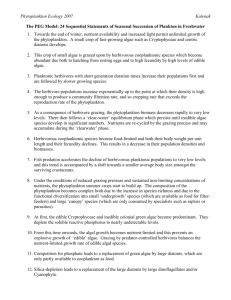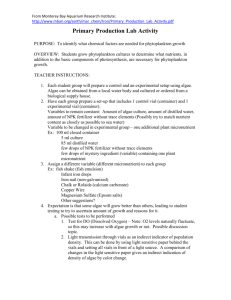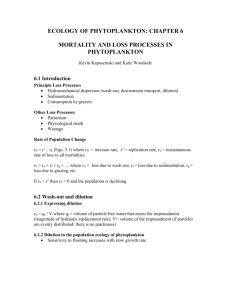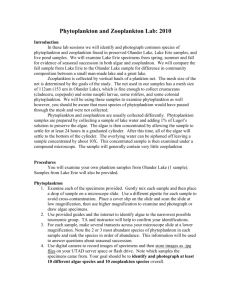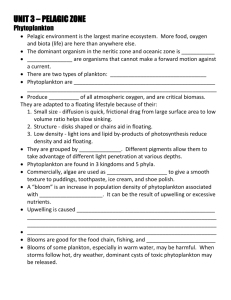Freshwater Plankton Taxonomy and Ecology
advertisement
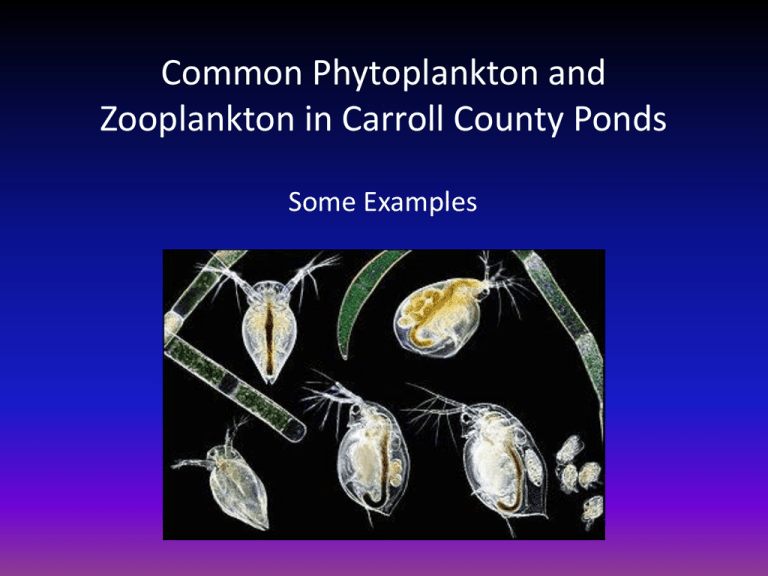
Common Phytoplankton and Zooplankton in Carroll County Ponds Some Examples Phytoplankton Kingdom Monera – The Blue-green “Algae” Nostoc sp. • Forms colonies composed of filaments of moniliform cells in a gelatinous sheath • Possess heterocysts (clear, thick-walled cells) capable of nitrogen fixation Phytoplankton Kingdom Monera – The Blue-green “Algae” Lyngbya sp. • Filaments lack heterocysts • Filaments with equal diameter throughout whole length • Rigid sheath that can extend beyond the cells in the filament Phytoplankton Kingdom Monera – The Blue-green “Algae” Merismopedia sp. • Cells arranged in perpendicular rows one cell thick to form rectangular colonies • The colonies may be flat or slightly wavy and are held together by colorless, indistinct mucilage Phytoplankton Division Chlorophyta – Green Algae Botryococcus sp. • Cells form an irregularly shaped aggregates, with thin filaments connecting cells. • Will bloom when in the presence of elevated levels of dissolved inorganic phosphorus • Has potential as a producer of biofuels Phytoplankton Division Chlorophyta – Green Algae Scenedesmus sp. • Colonies with 4, 8, or 16 cells arranged in a row. • Spines and bristles make the colonies more buoyant and allow them to uptake the light and nutrients that are more abundant near the surface, and may deter predation by herbivores • May be dense in nutrient- rich waters Phytoplankton Division Chlorophyta – Green Algae Ankistrodesmus sp. • Cells are long and needle- or spindleshaped, or sometimes curved or slightly crescent-shaped. • May be found individually, clustered, twisted around each other, or in tufts among other algae. • The parietal chloroplasts sometimes have pyrenoids Phytoplankton Division Chlorophyta – A Desmid Staurastrum sp. • Cells composed of two halves (semicells), often almost divided from each other by deep median incisions (True of all desmids) • Often bear elaborate ornamentation • Many small processes and arms tipped with spines Phytoplankton Division Bacillariophyta – Diatoms Fragilaria sp. • Frustules rectangular to lanceolate, in girdle view • Frustules are joined by small marginal spines to form ribbon like (band-shaped) colonies. Phytoplankton Division Chrysophyta – The Golden Algae Dinobryon sp. • Loricate • Lorica cylindrical and consisting primarily or entirely of cellulose and protein; vase- or Funnel-shaped and often with a slightly broadened mouth • Forming arbusculate (tree-like) colonies (rarely solitary) Phytoplankton Division Pyrrophyta – Dinoflagellates Peridinium sp. • Motile, single, golden-brown cells • Outer covering of rigid plates • Two flagella Phytoplankton Division Rhodophyta – Red Algae Porphyridinium sp. • Cell with pink to red chloroplasts • Cells solitary, but often grouped into irregular colonies with ill-defined mucilaginous matrix. • Forms gelatinous coatings on surfaces in freshwaters Zooplankton Kingdom Protista – Protozoans, Ciliates Prorodon sp. • Flexible ovoid body, round in cross-section • Mouth apical • Swims in large circles, revolving rapidly around the long axis of its body. • Eats bacteria, green algae, and small nematodes. Cytoplasm typically filled with food particles. Zooplankton Kingdom Protista – Protozoans, Ciliates Didinium sp. • Didinium are unicellular and have an oval shape and two rows of cilia • Front ends in a pointed snout (cytosome). • Free-living carnivores • Feed on other protists, dinoflagellates, and green algae Zooplankton Kingdom Protista – Protozoans, Ciliates Stentor sp. • Among the largest aquatic protozoans. Up to 2 mm long, they are larger than some of the smallest multicellular organisms • Usually attach to substrates and form a trumpet shape. • If they are free-swimming, they assume an oval or pear shape. • A major characteristic of Stentor is the rapid contraction and extension of the cell body. Zooplankton Phylum Rotifera – Rotifers Keratella sp. • A footless rotifer which possesses a protective covering, or lorica, made up of hexagonal plates • Has a crown of anterior spines • May or may not have a posterior spine Zooplankton Phylum Arthropoda, Class Crustacea, Order Ostracoda – Seed Shrimp Unidentified Ostracod • Jointed appendages • Body flattened from side to side and protected by a bivalve-like, chitinous or calcareous valve or "shell". • They have a wide range of diets, and the group includes carnivores, herbivores, scavengers, and filter feeders. Zooplankton Phylum Arthropoda, Class Crustacea, Order Copepoda – Seed Shrimp Cyclopoid Copepod (likely Cyclops sp.) • Jointed body and appendages • With a teardrop shaped body and large antennae. • Have a compound, median single eye, usually bright red and in the centre of the transparent head • Cyclopoid copepods have antennae shorter than length of body Zooplankton Phylum Arthropoda, Class Crustacea, Larval Stage Unidentified Nauplius larva • Jointed appendages • Oval body with 3 pair of appendages • Immature form of copepods, cladocerans, and ostracods


